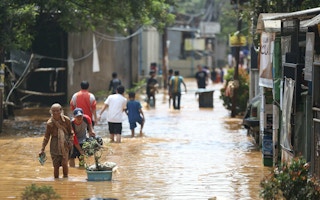The recent IPCC report released in April sets out clear evidence that the effects of climate change are accelerating, and Southeast Asia is one of the most exposed regions to this crisis. There is growing consensus within the scientific community that on the current trajectory, the world is not on track to avoid the maximum 1.5°C warming above pre-industrial levels to avoid the worst impacts of climate change. Even limiting our warming pathway to 1.5°C will mean serious consequences for many, including the 75 million Southeast Asian citizens living in low-lying regions.
We are already witnessing first-hand the accelerated climate-induced hazards reaping devastating impacts on social, economic, and environmental systems on a larger and more rapid scale. The 2021 flooding in Malaysia resulted in a number of deaths, and over 30,000 citizens evacuating their homes. Tropical storm Megi recently devastated Philippines, leaving scores dead and almost 20,000 displaced in what is traditionally the nation’s dry season.
These visceral impacts of climate change are set to be more prominent, and more frequent, in years ahead. This Earth Day, as we look to a theme of investing in our planet, it’s clear that nations of Southeast Asia must invest in their own climate adaptation and resilience.
Southeast Asia’s climate vulnerability
Southeast Asia is not only at serious risk of negative climate impacts due to its vulnerable geography, but also its relative preparedness levels.
The Notre Dame Global Adaptation Index (ND GAIN) analyses the vulnerability of nations against their readiness to adapt to these climate change impacts. Unfortunately, many Southeast Asian countries are at the intersection of high exposure, but low levels of readiness to adapt, including Cambodia, Laos, Myanmar, Philippines, and Vietnam. Any further delay will mean we miss a brief, rapidly closing window to secure a liveable future for all.
The time for Southeast Asia to invest in action is now, with a focus on adaptation and resilience:
- National adaptation planning. The issues surrounding effective adaptation are complex, affecting multiple systems and interrelated climate hazards, often requiring a highly localised view. Countries need a roadmap for adaptation planning that can be applied across multiple sectors, multiple hazards, and which can be cascaded from national to local level.
- Climate analytics to support decision making. There is a great deal of uncertainty when it comes to climate impact and intervention. Our experience reveals a significant disconnect between those who are involved in the data and those who make decisions. This gap can be bridged by translating climate data into insights which help decision makers understand impacts through the lens which matters most to them — society and the economy — so that they can evaluate trade-offs of different actions.
- Action mobilisation. We need to go beyond analysis to catalyse genuine action. We are leveraging our insights to rally action across both public and private sector — for example mobilising financing towards areas of highest need and facilitating collaboration between public and private players. This is vital if we’re to generate the greatest value from the imperative to invest in our planet.
The Boston Consulting Group is applying these capabilities in the Philippines, which is at the sharpest edge of the climate knife — ranked 119th for vulnerability and 133rd for readiness on the ND GAIN Index. Adaptation is extremely critical as the Philippines is frequently affected by natural disasters, with large vulnerable populations living in coastal areas with many informal settlements. Using sea level rise as an example of the potential impacts, we have applied climate analytics to demonstrate to stakeholders how we can answer critical questions around where, what, and how to invest in adaptability and resilience action.
In the social sphere, typical questions are around the potential impact of climate hazards to society. This can include which communities will be most affected, and in what way those effects will manifest. Through climate analytics we can zoom into the most affected areas and understand which population segments are most vulnerable to sea-level rises, how they are affected, and the potential trade-offs of different interventions.
In one city, home to 130,000 people, two of three local hospitals are vulnerable to flooding from water level rises of up to one meter. The clarity around this vulnerability enables policy makers to plan an appropriate strategic response and prioritise where to channel funding — dependent on risk tolerance do they take no action, introduce early warning systems, flood-proof buildings, or relocate facilities completely.
In the economic realm, typical questions revolve around which sectors and economic assets are most affected by climate change, and what the best and most economical ways to fund action are. In the case of the most vulnerable province to sea level rises, the manufacturing sector is the biggest contributor to gross domestic product, and the agriculture and fisheries sectors are projected to be severely affected by climate events. This has serious implications for those whose livelihoods rely on these sectors, and for food security in the region. Analytics can inform engagement between public and private players on collaborating on effective solutions.
In the natural world, Philippines must also assess impacts on its rich and biodiverse environment in areas such as rainforests and wetlands. Protection of these assets is important to both adaptation and mitigation, but our analysis indicates that up to half of wetlands in certain areas may be permanently damaged by severe events. More development funding is earmarked to invest in these assets, with funds such as the Green Climate Fund, Climate Action for a Resilient Asia, and others. With the analytics in place, government can advocate in an informed way for investment to protect these assets.
Earth Day is an opportunity to reflect on the wonderful, diverse, and interconnected nature of our planet. When championing vital climate investments, it’s also important to recognise the diversity of need across the world. In Southeast Asia, that means recognising the acute vulnerability to climate change, and the critical need to invest in adaptation and resilience actions now to ensure a future for all.
Dave Sivaprasad is the Southeast Asia leader for climate and sustainability at Boston Consulting Group. He is part of the group’s Climate & Sustainability Hub for Innovation in Asia. Anis Mohd Nor is a project leader at Boston Consulting Group’s Climate and Sustainability Practice.










